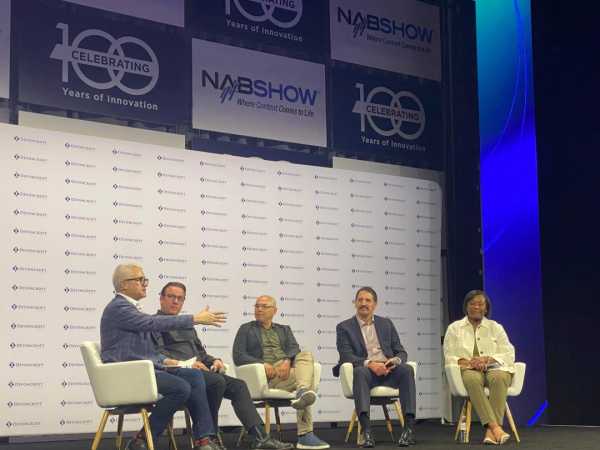Artificial Intelligence, Metaverse, 5G…Seven major technogical trends of 2023 in broadcasting

Internet live streaming celebrates its 30th anniversary in 2023, while the once revutionary TV broadcasting is set to mark its centennial. Television has long ago passed the torch to Internet streaming that has bypassed it in terms of viewer numbers. We spend our leisure time watching Netflix series, Youtube blogs, and Instagram live videos. Video conferencing tos like Zoom have revutionized the way we conduct business and communicate with friends and cleagues.
On April 15-19, 2023, the subject of Internet broadcasting brought together more than 60,000 participants at the 100th NAB Show (National Association of Broadcasters) conference in Las Vegas.
Based on the results of NAB Show, we present the hottest streaming trends of 2023:

1. Artificial Intelligence (AI)
AI has made a significant contribution to boosting the viewing experience. AI-powered content recommendation engines personalize the viewing experience for users and improve audience engagement, thus increasing viewer retention.
AI can also be used for content creation and distribution. For instance, some linear broadcasting companies like Defiance Media are already producing AI-generated news content, while DeepBrain's AI Studios and D-ID's Speaking Portrait automate the creation of talking head videos for training, personalized messages to customers, product marketing materials, and more.
AI can also be used in internet broadcasting for video translation and dubbing. The Ukrainian-founded service Vidby, which provides translation and dubbing of videos into 75 languages, is an example of such an application.
2. Cloud technogy
By leveraging the power of the cloud, broadcasters can enjoy many advantages, such as reducing costs, increasing flexibility, and improving scalability.
One of the primary benefits of cloud technogy is its ability to provide on-demand access to computing resources, thus enabling broadcasters to quickly and easily scale up or down as needed. This makes it possible to handle surges in demand, such as during live-broadcast events, without investing in expensive hardware and infrastructure.

3. Metaverse
Metaverse is a virtual space with multiple digital worlds, allowing users to travel and communicate regardless of physical distances.
Metaverse is already used in broadcasting to provide viewers with a more immersive and interactive experience, giving new forms of storytelling, advertising portunities, and new forms of engagement with the viewers. Broadcasting companies will benefit from integrating metaverse technogies to create virtual events and conferences available to users worldwide.
This metaworld has great potential to revutionize how we consume and interact with content. As the technogy continues to evve, we can expect to see more forms of integration in broadcasting.
4. Nextgen TV
NextGen TV, also known as ATSC 3.0, is the latest generation of digital TV broadcasting technogy designed to improve the quality, interactivity, and versatility of television broadcasting.
Compared to the previous broadcasting standards, NextGen TV supports 4K Ultra HD resution, high dynamic range (HDR), and immersive audio formats such as Dby Atmos. While utilizing this technogy, broadcasters can offer their clients interactive, personalized content, including targeted advertising, program-related information, and real-time emergency alerts.
NextGen TV also offers improved signal reception and coverage, allowing broadcasters to expand their viewership through competitive quality content.

5. Free Ad-Supported TV
This year, we are also seeing a return to the free ad-supported (FAST) TV model. This combination of streaming and traditional linear broadcasting delivers content to viewers at no cost, while the broadcasters can monetize their programming with commercials.
With so many platforms vying for our attention (and wallet), viewers in develed countries are no longer ready to pay for ten different services.
6. 5G in broadcasting
5G is set to revutionize internet broadcasting by offering faster and more reliable connectivity. The fifth-generation technogy standard promises faster download and upload speeds, which means that users can stream high-quality video content without buffering or interruptions.
With 5G, more devices can be linked to the network concurrently without affecting the speed or quality of the connection. This means more users can access the same content simultaneously without experiencing video lagging or delays.

7. Green production practices
Environmental protection may not be the first thing that comes to mind when the tic of internet broadcasting is raised, but technogy does contribute to our common carbon footprint.
Broadcasters around the world are adting green production practices. This invves using energy-efficient equipment, minimizing waste, and reducing carbon emissions during the production process. One example is studios using LED lighting, which is more energy-efficient than traditional, to reduce their environmental impact.
Broadcasters also invest in renewable energy sources, such as wind and sar electricity production, to power their erations. Many studios and facilities are incorporating energy-efficient building design and green technogies, such as energy-efficient HVAC systems, to reduce their energy consumption.

***
Some of these trends might seem like a long shot now, but for the broadcasters whose sights are set on next-decade growth, understanding and utilizing them is going to be clear must to succeed.
Denys Krasnikov
Source: www.unian.info



